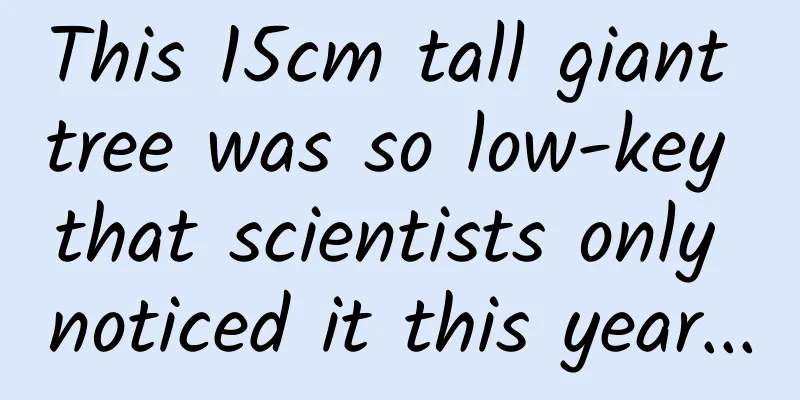This 15cm tall giant tree was so low-key that scientists only noticed it this year...

|
When you think of Big Mac, what’s the first thing that comes to your mind? Is it the best-selling burger? The super-powerful robots in Transformers? Or the largest creatures in the world, such as the 180-ton blue whale and the 115-meter-tall North American redwood? The one we are going to talk about today, although it looks ordinary, has recently become a new genomic "giant" in the eukaryotic world. It is T. oblanceolata from the genus Tmesipteris (for ease of reading, it will be referred to as "Tmesipteris" below, and the specific epithet oblanceolata means "oblanceolate") This title is well deserved, because the genome size of the Meixi fern is an astonishing 160.45 Gb! It breaks three world records at the same time - "largest fern genome", "largest plant genome" and "largest genome". Previously, the latter two records were held by Paris japonica with a genome size of 148.89 Gb since 2010. What does “160.45 Gb” mean? This starts with what a genome is, its size and how to measure it. The new "giant" T. oblanceolata plant (Image source: Fernández et al., 2024) The last "giant" Japanese Paris polyphylla plant (Photo credit: PPBC-Wu Baocheng; Alpsake/Wikimedia Commons) Part 1 How big is a genome ? Genome has two levels of meaning: at the species level , the genome refers to the genetic information that is extremely similar but slightly different in all individuals of a species; at the individual level , the genome refers to the sum of genetic material present in all cells of a certain organism, including DNA or RNA (some viruses). In the grand poem of life, DNA is the mysterious weaver, weaving endless genetic codes with four basic letters - adenine (A), thymine (T), cytosine (C) and guanine (G). Just like dominoes, the fall of each domino triggers a chain reaction. The arrangement and combination of these bases determines the diversity of organisms, allowing each life form to have its own unique genetic blueprint. So, how do we measure "how much" genetic information there is? Generally speaking, there are three ways to measure the genetic information of an organism: (1) C value calculated by weight, usually in picograms (10-12 grams, pg); (2) calculated by molecular weight, in daltons; (3) expressed as the number of nucleotide base (ATCGU) pairs. The most common method of measuring genome size is to express it in terms of the number of nucleotide base pairs. Similar to the unit of computer storage capacity, we define the "capacity" of a base pair as 1 bp (base pair). If the base pairs are connected, one thousand is 1 Kb, one million is 1 Mb, and one billion is 1 Gb. However, unlike computer storage capacity, the increment rate of computer storage size is 1024, while the increment rate of genome size is 1000. So how do we determine the genome size of a species? At present, we can estimate it through flow cytometry, K-mer analysis, and de novo genome sequencing . These three methods have successively improved the accuracy of assessing genome size, but correspondingly, their technical difficulty, accuracy, and cost have also increased. With the rapid development of third-generation sequencing technology, the cost of genome sequencing has been significantly reduced. Now the price of completing deep sequencing, assembly, and annotation of a 1 Gb genome has dropped to less than 100,000 yuan. However, even if the cost drops significantly, the high cost of such a large project as the 160 Gb Meixi fern genome is still only affordable by a few wealthy teams. Furthermore, before assembling the genome by third-generation sequencing, flow cytometry or K-mer method is generally used to "survey" the size of the genome. Therefore, in this study, researchers first arranged for the more "economical" flow cytometry to estimate the size of the Meixi fern genome. The principle of flow cytometry is to prepare a cell nucleus suspension, fluorescently stain the nucleic acid, and use a species with a known genome size as a reference. According to the horizontal coordinate of the relative fluorescence density (DNA content) peak between the two species, the genome size is calculated in proportion. As shown in the figure below, the ratio of the peak horizontal coordinates of Pteris chinensis and Rhizoma Polygoni Orientalis, whose genome size is 148.89 Gb, is 1.12 (226.60/202.28), indicating that the genome size of Pteris chinensis is about 1.12 times that of Rhizoma Polygoni Orientalis! This study used allium, Fritillaria lusitanica, and Rhizoma Polygoni Orientalis as internal references, and the final estimated genome size of Pteris chinensis is 160.45 ± 0.81 Gb. Flow cytometry results of Pteris chinensis and Paris polyphylla (Image source: Fernández et al., 2024) Part.2 A big genome but a small body? Despite its giant genome, the plant looks quite small and inconspicuous. T. oblanceolata is a small genus in the Psilotaceae family, containing 15 species, 12 of which are epiphytic. The protagonist of this article, T. oblanceolata, is relatively rare. It is found on New Caledonia and some neighboring islands in the southwest Pacific Ocean, with a maximum height of 15 cm. The genus T. tannensis is not only miniature, but also a niche group in the eyes of scientists. So far, the genome sizes of only two species in this genus have been reported, namely the tetraploid T. tannensis (73.19 Gb) and the octaploid T. obliqua (147.29 Gb), both of which have giant genomes. Professor Jaume Pellicer, the corresponding author of this study, is investigating the habitat of the epiphytic Pteris fasciata (Photo credit: Oriane Hidalgo) Professor Ilia J. Leitch, a botanist from Kew Gardens and one of the participants in this study, used a vivid metaphor to describe how ridiculously large the genome of the fern is - if the folded DNA in its cells is unrolled like a thread, the length can exceed 100 meters. In comparison, the human genome is about 3.1 Gb, and the length of the DNA in each cell after unrolling is only about 2 meters! If two pairs of bases are counted as one byte according to the size ratio of letters and Chinese characters, the genome of the fern can write 110,000 copies of "Dream of Red Mansions" (731,000 words/copy), which is equivalent to the collection of a library! So, is there a correlation between genome size and organism size? Is a larger genome better for a species? In fact, the famous " C-value paradox " has answered the first question. The theory proposes that there is no strict correspondence between the genome size (C-value) of a species and its evolutionary complexity, and there is even less correlation between genome size and organism size. And contrary to what people think, having a larger genome is usually not an advantage . This is because the larger the genome, the more DNA is synthesized, the more energy and nutrients are needed, and the higher the energy demand for replicating the genome each time the cell divides. Taking plants as an example, plants with large amounts of DNA are usually those slow-growing perennial plants, which have lower photosynthesis efficiency and require more nutrients to grow, reproduce and produce offspring more slowly, and may also be slower to adapt to the environment. Professor Ilia J. Leitch believes that trying to manage such a huge amount of genetic information is as absurd as "trying to find a few instructions on how to survive in such a huge amount of DNA in a library with millions of books." After all, only a small part of the DNA in the genome is composed of protein-coding genes. So how did the Meixi fern survive with such a large genome? How did it manage the complex genetic information in its genome? First, we need to understand where the Meixi fern's large genome came from. ** Part.3 If you want to make the genome "crazy expand", there are two ways to achieve it. The genome size of plants varies dramatically. The plant with the smallest genome is Genlisea aurea, a carnivorous plant in the family Utriculariaceae. Its genome size is only 0.0636 Gb. With the addition of Pteris serrata, the range of plant genome size has expanded to an astonishing 2,500 times (160.45/0.0636). Current research suggests that the variation in genome size is mainly driven by two factors. 1. Genome polyploidization Refers to the phenomenon that a species forms a new species with stable inheritance by causing multiple sets of chromosomes to coexist in the same cell nucleus through chromosome doubling. This is similar to the "luxury package" of polyploids ordering several genomes at the same time. For example, in the genus Oryza, the diploid spotted wild rice and medicinal wild rice, whose genomes are about 400 Mb and 600 Mb respectively, hybridized and polyploidized to produce the allotetraploid small-grain wild rice, whose genome reaches 1Gb. 2. Expansion of repeat sequences DNA sequences that appear repeatedly in the genome are called repetitive sequences, such as transposons (a type of DNA sequence that can replicate and move autonomously on chromosomes). Since most transposons do not have gene coding capabilities, they were once called "junk sequences." However, with the development of science and in-depth research, scientists have also discovered that repetitive sequences are not only an important part of large plant genomes, but also an important driving factor in genome evolution. Taking parasites as an example, generally speaking, in order to reduce their own load and energy consumption, they will try to simplify their genomes as much as possible, but parasitic flowers have a large genome of 3.5 Gb, of which up to 90% of the sequences are composed of highly repetitive transposons. Although its genome looks very "huge", in fact the structure of most genes is very simple, and the number of gene loss is extremely high, making it a veritable "fat player". Although the genome of the fern has not yet been resolved and cytological data has not yet been collected, we do not know how ferns cope with the consequences of such an unnecessary giant genome. However, scientists speculate that the fern's genome "Big Mac" package is customized like this: polyploid identity or "puffy" redundant sequences? It doesn't make a choice, it takes it all! Polyploid identity Compared with angiosperms, ferns usually have a higher number of chromosomes in their cells, a phenomenon also known as "chromosome hoarding syndrome". The chromosome base number in a single chromosome set of the genus Pteris has reached x = 52. In addition, existing evidence has found that there are many tetraploids and octoploids in the genus Pteris, which is really full of buffs! High sequence The researchers speculate that the giant genomes of multiple species of the genus Pteris may be related to their "epiphytic" properties. Perhaps similar to parasitic flowers with "parasitic" properties, there are also highly redundant repetitive sequences in their genomes. In addition, based on previous large genome research cases, we can also boldly speculate: there may be some highly expanded gene families in the Meixi fern genome, which play an important role in its adaptation to the environment ; a large number of gene loss events may have occurred in the Meixi fern genome, and only a small number of genes controlling key traits have been retained. These genes may be the key to the successful management of the Meixi fern's giant genome ; the current population of Meixi fern is so small, has it ever experienced a bottleneck effect, reducing its genetic diversity and accumulating a large number of harmful mutations? Will this species face a crisis of survival in the future? Does it need to take protective measures? Of course, the answers to all these questions will have to wait for the "tycoon" team to analyze the genome and then be revealed by evolutionary biologists. Part.4 What other genomic “giants” are there? In addition to the protagonist of this article, there are actually many organisms in nature with genome sizes exceeding 100 Gb, such as Pteris, Paris japonica, Trillium, Viscum glabra in plants, and various lungfish and mud salamanders in animals. Although some of these organisms can run, jump, and paddle, some take root in the soil to absorb the essence of the sun and the moon; some are extremely beautiful, while others are plain; some are "strong and healthy", while others are weak and fragile...but they all have a common name - genome "giant"! Organisms with known genome sizes exceeding 100 Gb (Image translated from: Fernández et al., 2024) Could there be an organism with a genome larger than that of the plum brook fern? Everything is possible! Perhaps, the next time you are in the wild in the mountains or in the city park, an inconspicuous grass you come across may be a hidden genomic giant. References: [1] Fernández et al., A 160 Gbp fork fern genome shatters size record for eukaryotes. iScience, 2024,109889. [2] Cai et al., Deeply Altered Genome Architecture in the Endoparasitic Flowering Plant Sapria himalayana Griff. (Rafflesiaceae). Current Biology, 2020, 31: 1-10. [3] Unlocking the Genetic Giant: Tiny Fern Has the Largest Genome of Any Organism on Earth. Kew Science, 2024. [4] Schupak A. Largest known genome is within this plain plant on the forest floor, study says. CNN, 2024. [5] Leushkin et al., The miniature genome of a carnivorous plant Genlisea aurea contains a low number of genes and short non-coding sequences. BMC Genomics, 2013, 14: 176. Source: Science Institute |
<<: Can smelly car exhaust be made “cleaner”?
Recommend
National Fitness Day丨If you don’t do fitness correctly, you will just waste time? Learn about these fitness misunderstandings
Today is National Fitness Day. Do you know how to...
Master these 12 tips for social monetization
Today I would like to talk to you about how to qu...
Watch the ever-changing Earth from afar: How are meteorological satellites launched?
The launch vehicle gives the artificial satellite...
Mars Era 2021 Film and Television Editing Course [HD Quality]
Mars Era 2021 Film and Television Editing Course ...
Essential for developers: 2018 Android SDK tool recommendations
Pimple Popper is an app that pops virtual pimples...
The "big sister" who loves hot dry noodles took the time to publish a top magazine and refreshed history
Recently, the international top journal Cell publ...
Staying up all night will "activate" inflammation in the body
A report released by the Chinese Sleep Research S...
The 4-year evolution of WeChat H5 marketing: from .ppt to .avi (classic case collection + in-depth analysis)
“H5 is no longer good!” “H5 has been made into a ...
From 0 to 1 entry-level e-commerce store operation plan!
Many friends who do e-commerce often come to cons...
The decline in electronic product imports and exports narrowed, and the growth rate of the home appliance industry slowed down
As my country's stimulus policies gradually t...
Why do male crabs experience "false pregnancy" after being parasitized?
When it comes to parasites, humans always condemn...
Most orange cats are male, while calico cats are female? Scientists find the key reason →
Compiled by: Gong Zixin Image source: pixabay No ...
How to use the 4-step growth mindset to create creative marketing plans for the Chinese Valentine’s Day?
The Chinese Valentine's Day is coming soon. E...
Sun Yingsha and Liang Jingkun won the championship. Does the quality of playing table tennis have anything to do with the racket?
Table tennis, as my country's national sport,...
When Joyoung meets intelligence, the healthy kitchen of the future will come sooner
Smart homes allow us to see and feel more and mor...









